
The beagle is a breed of small scent hound, similar in appearance to the much larger foxhound. The beagle was developed primarily for hunting hare (beagling). Possessing a great sense of smell and superior tracking instincts, the beagle is the primary breed used as a detection dog for prohibited agricultural imports and foodstuffs in quarantine around the world. The beagle is intelligent. It is a popular pet due to its size, good temper, and a lack of inherited health problems.

The Labrador Retriever or Labrador is a British breed of retriever gun dog. It was developed in the United Kingdom from fishing dogs imported from the independent colony of Newfoundland, and was named for the Labrador region of that colony. It is among the most commonly kept dogs in several countries, particularly in the Western world.

The German Shepherd is a breed of medium to large-sized working dog that originated in Germany. According to the FCI, the breed's English language name is German Shepherd Dog. The breed name was officially known as the "Alsatian Wolf Dog" in the UK from after the First World War until 1977 when its name was changed back to German Shepherd. Despite its wolf-like appearance, the German Shepherd is a relatively modern breed of dog, with its origin dating to 1899.

The Australian Federal Police (AFP) is the national and principal federal law enforcement agency of the Australian Government with the unique role of investigating crime and protecting the national security of the Commonwealth of Australia. The AFP is an independent agency of the Department of Home Affairs and is responsible to the minister for home affairs and accountable to the Parliament of Australia. As of October 2019 the commissioner of the Australian Federal Police is Reece Kershaw, formerly the Northern Territory Police Commissioner.
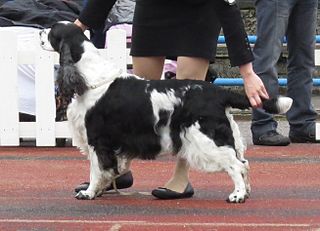
The English Springer Spaniel is a breed of gun dog in the Spaniel group traditionally used for flushing and retrieving game. It is an affectionate, excitable breed with a typical lifespan of twelve to fourteen years. They are very similar to the Welsh Springer Spaniel and are descended from the Norfolk or Shropshire Spaniels of the mid-19th century; the breed has diverged into separate show and working lines. The breed suffers from average health complaints. The show-bred version of the breed has been linked to "rage syndrome", although the disorder is very rare. It is closely related to the Welsh Springer Spaniel and very closely to the English Cocker Spaniel; less than a century ago, springers and cockers would come from the same litter. The smaller "cockers" hunted woodcock while the larger littermates were used to flush, or "spring", game. In 1902, The Kennel Club recognized the English Springer Spaniel as a distinct breed. They are used as sniffer dogs on a widespread basis. The term Springer comes from the historic hunting role, where the dog would flush (spring) birds into the air.

The Australian Cattle Dog (ACD), or simply Cattle Dog, is a breed of herding dog originally developed in Australia for droving cattle over long distances across rough terrain. This breed is a medium-sized, short-coated dog that occurs in two main colour forms. It has either brown or black hair distributed fairly evenly through a white coat, which gives the appearance of a "red" or "blue" dog.
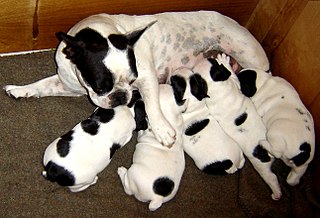
Dog breeding is the practice of mating selected dogs with the intention of maintaining or producing specific qualities and characteristics. When dogs reproduce without such human intervention, their offspring's characteristics are determined by natural selection, while "dog breeding" refers specifically to the artificial selection of dogs, in which dogs are intentionally bred by their owners. Breeding relies on the science of genetics, hence a breeder who is knowledgeable on canine genetics, health, and the intended purpose of the dogs attempts to breed suitable dogs.
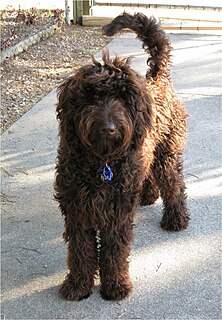
A Labradoodle is a crossbreed dog created by crossing the Labrador Retriever and the Standard, Miniature, or Toy poodle. The term first appeared in 1955, but was not initially popular. Labradoodles are considered a good choice for people with canine dander allergies, since some have the same hypoallergenic coat as their poodle ancestors.

A herding dog, also known as a stock dog, shepherd dog, sheepdog or working dog, is a type of dog that either has been trained in herding or belongs to breeds that are developed for herding.

Police dog is an anthropomorphisizing term for a dog that is specifically trained to assist police and other law-enforcement personnel. Their duties include: searching for drugs and explosives, locating missing people, finding crime scene evidence, and attacking people targeted by the police. Police dogs must remember several verbal cues and hand gestures. The most commonly used breeds are the German Shepherd, Belgian Malinois, Bloodhound, Dutch Shepherd, and the retriever breeds. Recently, the Belgian Malinois has become the dog of choice for police and military work due to their intense drive and focus. Malinois are smaller and more agile than German Shepherd Dogs, and have fewer health issues. However, a well-bred working line German Shepherd Dog is just as successful and robust as a Malinois.

The Canada Border Services Agency is a federal law enforcement agency that is responsible for border control, immigration enforcement, and customs services in Canada.
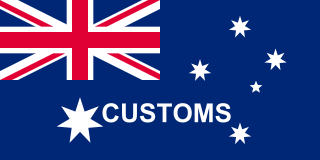
The Australian Customs and Border Protection Service was an Australian federal government agency responsible for managing the security and integrity of the Australian border and facilitating the movement of legitimate international travelers and goods, whilst protecting the safety, security and commercial interests of Australians. It was headquartered in Canberra and employed over 5,800 people around Australia and overseas.

A detection dog or sniffer dog is a dog that is trained to use its senses to detect substances such as explosives, illegal drugs, wildlife scat, currency, blood, and contraband electronics such as illicit mobile phones. The sense most used by detection dogs is smell. Hunting dogs that search for game, and search dogs that work to find missing humans are generally not considered detection dogs. There is some overlap, as in the case of cadaver dogs, trained to search for human remains.

Guiding Eyes for the Blind is one of eleven accredited schools in the U.S. for training guide dogs—dogs trained to lead the blind and visually impaired. It houses a 10-acre (40,000 m2) headquarters, training center and veterinary clinic in Yorktown Heights, New York, and it also operates a canine development center in Patterson, New York, and a training site in White Plains, New York.

The Golden Retriever is a medium-sized breed of retriever developed in the United Kingdom. The Golden Retriever's gentle and affectionate nature and its striking golden coat has made it one of the Western world's most recognisable and popular dog breeds. The breed is also still employed as a gundog, is a popular competitor in obedience trials, is sometimes trained for use as guide dogs as well as being widely kept as a pet.
Steve Austin is an Australian dog trainer, who has been training dogs for over 30 years. He is renowned as one of Australia's top animal trainers, with a particular skill in dog behaviour and training. His lifetime in dog training has seen him train animals for quarantine, search and rescue, police work, and wildlife preservation, among other roles. He has also travelled internationally lecturing and training dogs.
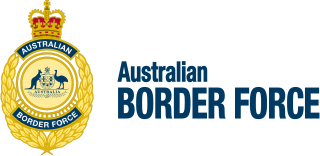
The Australian Border Force (ABF) is a law enforcement agency, part of the Department of Home Affairs, responsible for offshore and onshore border control enforcement, investigations, compliance and detention operations in Australia.

The National Explosives Detection Canine Team Program is a program administered by the Transportation Security Administration which uses law enforcement and TSA-run explosive detection dog teams to detect explosives in transportation environments.

CISF Unit Delhi Metro Rail Corporation is a Central Industrial Security Force (CISF) unit responsible for providing security cover to Delhi Metro, Delhi, India. The Unit is headed by a Deputy Inspector General who is an Indian Police Service officer; the incumbent is Jitender Rana, a 2005 IPS officer from Bihar cadre. The Headquarters of the Unit is situated at Shastri Park near Delhi IT Park. It is the single largest unit of CISF in the country with sanctioned strength of 12,528 personnel. The Unit operates two control rooms for better monitoring and coordination and has different specialised wings such as the Quick Reaction Team, Dog Squad and Bomb Detection Squad.

















